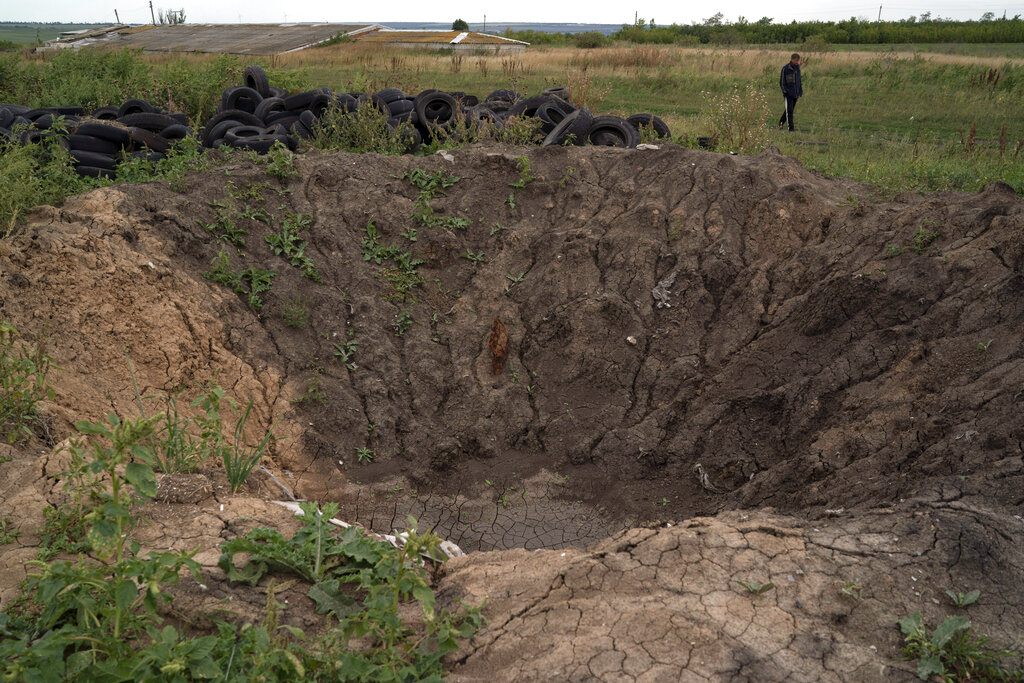Kiev– An undetonated rocket is seen in a field and another is embedded in the ground in the farm complex. Some workers found a cluster bomb when they were pulling weeds and there is a huge hole in the roof of the barn, marked by shells.
All work has been suspended on this farm in eastern Ukraine, whose fields and buildings have been hit so many times by mortars, rockets, missiles and bombs that its workers are unable to sow the land or harvest wheat.
Replanting and harvesting “will be difficult, very difficult,” said Viktor Lubinets, who is in charge of production at the Veres farm. Even if the fighting ceases, the fields must be cleared of ammunition and shrapnel.
And there is a long way to go before the fighting ends. The roar of a projectile fills the air, the nearby detonation shaking the ground and sending a plume of black smoke into the air. Lubinets barely blinks.
“I’ve gotten used to it. It was scary in the early days, but now a person gets used to anything,” the 55-year-old farmer said, smoke clearing behind him. “And we have to work. If we leave everything, other peasants will do the same, what happens then?”
Agriculture is key to the Ukrainian economy, accounting for about 20% of gross domestic product and 40% of export earnings before the war, according to the UN Food and Agriculture Organization (FAO).
The country is often described as the breadbasket of Europe and millions of people depend on its supplies of grains and sunflower oil in Africa, the Middle East and parts of Asia where many already face hunger.
But the Russian invasion on February 24 has dealt it a severe blow, damaging fields, crops, livestock, machinery and warehouses, as well as severely hampering transport and exports.
The FAO estimated in July that the preliminary damage to the sector ranges from 4.3 billion to 6.4 billion dollars – from 15% to 22% of the total value of pre-war agriculture in Ukraine – estimated at 29 billion.
The Veres farm is a stark example. Its 5,700 hectares (14,085 acres) of land usually produce wheat, barley, corn and sunflowers, and it had 1,500 head of cattle.
But its location made it especially vulnerable in what has been an artillery war. The farm lies almost directly on the line between the strategic city of Izium, captured by Russian troops in early April and recaptured by Ukraine in September, and Kramatorsk, the largest city in the eastern Donetsk region still in Ukrainian hands.
The farm compound has been hit by attacks 15 to 20 times, Lubinets says, and he has lost count of how many times shells have landed in the fields. The barn has been shelled, the power generation facility has been destroyed and numerous rockets have landed on the cattle barn, which has been empty since the animals were sold at the start of the war. Of the pre-war workforce of 100 employees, most were evacuated and only 20 remain.
The workers managed to plant wheat, but did not have time to harvest it. Crops burned in a shelling on July 2.
Lubinets was devastated. As an agronomist, he was eager to examine the results of five new types of wheat he had planted as part of an annual crop yield study.
“All that studio work was destroyed,” he said. “How can I feel? How can a person feel if he wants to do something, but someone comes and ruins it?”
Some farms in the area have been more fortunate. Nearly 10 kilometers (6 miles) southwest of Novomykolaivka, a combine harvester moves methodically through a field, separating sunflower blossoms from their stems and dumping the seeds into the backs of trucks.
The war creates a shocking background. The machine is scarred by rocket shrapnel and an adjoining field is mined. Helicopters fly over the corn and sunflowers and fighter planes fly over the plains.
“It became very difficult and scary to work during the war, because you don’t know what to expect or where,” said Maksim Onyshko, 36. “War has never caused anything good. Just pain and damage.”
Sergiy Kurinnyi, director of the 3,640-hectare KramAgroSvit farm, said it had been a risk planting sunflowers in May without knowing whether the front line would engulf the fields.
“We could see with our own eyes the military actions,” he said. “So there was a risk of whether or not we could harvest those crops, but we decided to take the risk.”
It paid off and the good weather helped produce a good yield from the 1,308 hectares of sunflowers. They also planted 1,434 hectares of wheat, 255 of barley, 165 of rapeseed and cattle feed. They lost 27 hectares of wheat in a fire caused by shelling, but managed to harvest the rest.
A rocket killed 38 of the farm’s 1,250 cattle in April, prompting managers to sell nearly all of the remaining herd — leaving 215 in its milk supply.
The next day, a rocket hit the equipment storage area, destroying a grain harvester and damaging other machinery, Kurinnyi said.
The workers, on a lunch break, ignore the explosions of distant cannonades.
Calculating the total losses was not easy, Kurinnyi said, but he estimated that about 10 million hryvnias ($270,000) had been lost from crop production and about 1 million hryvnias ($26,700) from the 38 cattle. killed in the attack.
With Ukraine’s counteroffensive pushing the front line further east, they say they feel more confident they can plant and start preparing the ground for winter crops.
But for the damaged farm where Lubinets works, a return to the fields is a long way off.
“We lived quietly before the war, we had achieved something, we were trying to do something. So what now?” she said.
“Everything has been damaged, everything has been destroyed and we have to rebuild all of this, start from scratch.”

